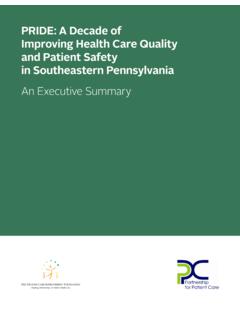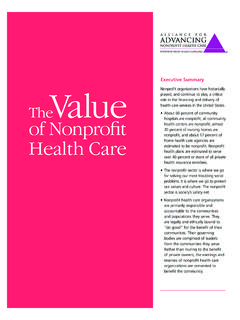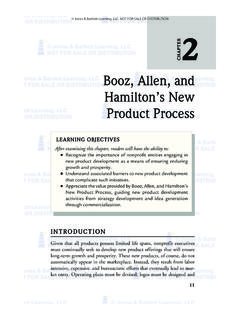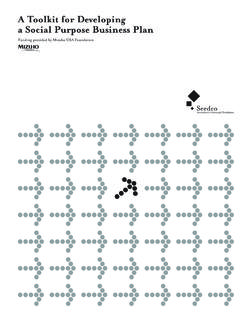Transcription of PRIDE: A Decade of Improving Health Care Quality …
1 PRIDE: A Decade of Improving Health Care Quality and Patient Safety in Southeastern Pennsylvania An executive summary Message from the President Since 2006, the Health Care Improvement Foundation has proudly joined forces with Independence Blue Cross and local hospitals in promoting improvement in the Quality and safety of care delivered to patients in our region. The Partnership for Patient Care (PPC) has represented a groundbreaking collaborative effort among hospitals and Health systems, in what is otherwise a very competitive southeastern Pennsylvania market. As the tenth year of our collaboration approached, HCIF's board identified our obligation to be accountable to our community for the effectiveness of our work. We engaged the services of our longtime data partner, the Pennsylvania Health Care Quality Alliance, to conduct an independent review of the performance of southeastern Pennsylvania hospitals over the last Decade . In a time of sweeping change in Quality measurement and public reporting, the report provides important evidence of how hospitals have risen to the challenge of Improving care, from preventing infections to reducing hospital readmissions.
2 At the same time, it is clear that gaps in Quality and safety persist, and will require renewed commitment by every stakeholder in the system as we begin our next Decade . HCIF supports the value of transparency in undertaking the difficult and complex work of Improving healthcare Quality . We welcome your review of this report and hope you will gain a better understanding of our region's performance in meeting the healthcare needs of patients and consumers. Kate J. Flynn, FACHE. President Health Care Improvement Foundation 2. The Health Care Improvement Foundation The Health Care Improvement Foundation (HCIF) is an independent nonprofit that leads Health care initiatives aimed at Improving the safety, outcomes, and care experiences of all patients, residents, and consumers. Founded in 1980 as an affiliate of the Delaware Valley Healthcare Council of HAP, HCIF. Our community's Quality of care and patient safety have benefitted has operated since 2003 as an independent 501(c)(3) organization.
3 HCIF has from Holy Redeemer been working together with hospitals and physicians on Quality improvement Health System's initiatives aimed at meeting and sustaining high levels of performance. In 2006, HCIF launched the Partnership for Patient Care (PPC) with financial support participation in the from Independence Blue Cross and local area hospitals. The overarching goal HCIF and PPC programs was to accelerate the adoption of evidence-based clinical practices by pooling over the past ten years. the resources, knowledge, and improvement efforts of Health care providers in Southeastern Pennsylvania (SEPA). This unique collaboration between The combination of payer and providers to share successful experiences and to jointly fund Quality identification of need, improvement initiatives has been recognized as a national model and has led to the development of fifteen separate programs in the last ten years. common definitions, shared resources, To celebrate the tenth year of PPC's efforts to transform Health care Quality in SEPA, HCIF asked the Pennsylvania Health Care Quality Alliance (PHCQA), to including best practices, assist in the development of a report that summarizes the progress in Health care cooperative efforts, Quality and patient safety in SEPA.
4 And sharing of results PHCQA's Analysis have been powerful in . bringing about these In order to evaluate the extent to which Health care Quality and patient safety improvements. have improved in SEPA, PHCQA extracted, analyzed, and compared data from numerous publicly available sources such as CMS, the Joint Commission, Pennsylvania Health Care Cost Containment Council (PHC4), and the Dr. Charles Wagner Holy Redeemer Hospital Pennsylvania Department of Health . PHCQA generated benchmarks based on hospitals in the SEPA area, calculated averages of hospitals participating in various HCIF projects, and compared those data to overall Pennsylvania and national averages. Where available, PHCQA also examined internal results from individual HCIF projects. Particularly close attention was paid to hospital performance before, during, and after a relevant HCIF project. Unfortunately, for some Quality indicators, the years of available data did not correspond with the timeframe of the projects.
5 In addition, current commonly endorsed measures often relate only to certain components of HCIF projects, and thus, provide only a small glimpse of a given project's net impact. Even when measures perfectly aligned with the timing and focus of the HCIF projects, correlations were difficult to make given the large number of concurrent Quality improvement initiatives and other regulatory and reimbursement model changes. 3. The Changing Landscape of the Health Care Industry During the last Decade , the Health care industry has been characterized by a rapidly changing landscape. Several factors, including federal and state Quality improvement campaigns, expanded Health insurance coverage, and evolving payment models, such as the implementation of pay-for-performance programs, have shaped the environment in which hospitals operate and physicians practice medicine. Some portion of HCIF's success in Quality improvement can be attributed to these external forces.
6 On the other hand, some of these external factors provided HCIF with an opportunity to address a particular issue due to the salience of the targeted topic among providers. Joint PA Initiative Commission's US Initiative Health HCIF Project Literacy Campaign eHealth American 5 Million Lives Collaborative Reinvestment Campaign Grant and Recovery PA Health MCARE: Act CARE 4 Us Exchange Reduction Hospital Value-Based EMS Act OB Adverse of HAIs IPPIP Program Engagement Purchasing Events Federal Health Health IT Act Affordable Networks Payments Health Equity AF4Q SCPA Collaborative Exchange Care Act Order SEPA SMRT PA-HEN PA Innovation PA Medicaid Partnership PA Pressure Antimicrobial Regional SEPA-READS Model Grant Expansion for Patient Fight MRSA Ulcer C. diff Safe Use of Stewardship Palliative Care Care Alliance Partnership Prevention PAVE Project HYDRO morphone Collaborative ED Transitions Collaborative PURC. 2006 2007 2008 2009 2010 2011 2012 2013 2014 2015.
7 PRIDE. PHCQA identified four common characteristics that HCIF employs across many of its programs that have contributed to their overall success: Promoting partnerships, Reducing harm, Increasing Delivery efficiency, and Engaging patients. Promoting partnerships refers to the need for individuals and organizations from different areas of the Health care industry to work together in order to improve the overall Quality of Health care by promoting better outcomes and reducing costs. Reducing harm requires a concerted focus on the reduction and prevention of hospital-acquired infections (HAI) and unintentional injuries by implementing standard protocols and best practices. Increasing delivery efficiency is the process of implementing various strategies to deliver high value care. This can be achieved by minimizing unnecessary tests and procedures, providing equitable care to all, and Improving coordinated care between caregivers and settings. Engaging patients encourages the promotion of Health literacy, improves communication between patients and providers, and empowers patients to participate in decisions about their own treatment options.
8 Informed patients are better able to carry out provider recommendations, understand the purpose of their medications, and identify symptoms and signs that may signal a worsening condition. 4. Promoting Partnerships Partnerships in today's dynamic Health care environment are increasingly important in order to be successful and effectively respond to market changes. PPC is a unique partnership between providers and payers that encourages different providers that often compete for services to work together in ways that would be difficult to do without a neutral convening organization like HCIF. Promoting the effectiveness of regional partnerships has been a hallmark of HCIF's approach to Quality improvement. To date, over fifty Health care facilities in the SEPA region have participated in at least one HCIF Quality improvement project. CARE 4 Us: Creating a Better Environment for Seriously Ill Patients In July 2012, HCIF implemented CARE 4 Us, a PPC project designed to raise awareness of palliative care as well as to increase the number and improve Crozer-Chester Medical the Quality of palliative care programs in the SEPA region.
9 In this 18-month Center's palliative collaborative, HCIF partnered with hospitals to develop and enhance their care team, a Track 2. palliative care programs. participant, has grown CARE 4 Us hospital participants were placed into one of two tracks: Track 1 for through participation in hospitals with a developed palliative care program, Track 2 for hospitals with no CARE 4 Us to include existing palliative care program. Track 1 hospitals received assistance in obtaining full-time medical the Joint Commission's Advanced Certification for their palliative care programs. director Dr. Cheryl This certification recognizes hospital inpatient programs that demonstrate Denick, Palliative Care exceptional care in optimizing the Quality of life for adult and pediatric patients Practice Administrator suffering from serious illnesses. Three Track 1 hospitals received Joint Commission Terry Sandman, a Certification for their palliative care programs during the collaborative.
10 Full-time physician Five Track 2 hospitals received assistance in the development of their palliative care assistant, and a part- programs. All five of these hospitals successfully completed Palliative Care Leadership time coding specialist. Center (PCLC) training offered by the Center to Advance Palliative Care. Following the CARE 4 Us collaborative, four hospitals had initiated palliative care services. Reducing Readmissions: Keeping Patients Healthy and Out of the Hospital Through the implementation of readmission prevention initiatives, HCIF and participating hospitals have worked to improve the culture of Health in SEPA HCIF facilitated by avoiding repeat admissions. In May 2010, HCIF launched Preventing educational webinars Avoidable Episodes: Smoothing the Way for Better Transitions (PAVE), and meetings to a PPC initiative that aimed to reduce readmissions by 10% over 18 months provide 53 SEPA. and improve care transitions for patients discharged from hospitals.









